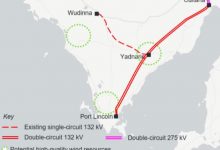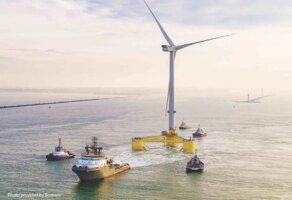Hopes to unlock the major wind resource on the west coast of South Australia’s Eyre Peninsula, and build some of the biggest wind farms in the country, appear to be dashed after the local transmission company ElectraNet chose a more modest spending option.
ElectraNet announced on Thursday that its favoured options was to spend $240 million building a new double-circuit 132 kV transmission line from Cultana to Port Lincoln, via Yadnarie, by the end of 2021.
It says this will be virtually cost neutral, because it means it won’t have to spend money on an upgrade and ongoing maintenance of the existing line – and will unlock some constraints that limit the output of the two existing wind farms on the peninsula – Mt Millar and Cathedral Rocks.
It says, however, that while the new line could support up to 500MW of new wind generation, south of Yadnarie at the half way point, it sees no value in a bigger, more expensive line to the west of the peninsula, where huge wind resources of 4,000MW have been identified.
It also chose against a big battery near Port Lincoln, at the end of the peninsula, to replicate the Dalrymple battery soon to be commissioned next to the Wattle Point wind farm on the Yorke Peninsula, and also rejected creating a series of micro-grids.
A so-called “green grid” unlocking at least 4000MW of “easily harvested” wind – and latterly solar – developments – has been proposed for at least a decade, and was the subject of a big study by Macquarie Group and others in 2010.
But its prospects have diminished in recent years, largely because of extensive developments elsewhere and the falling cost of solar, and was largely ignored in the recent Integrated System Plan put together by the Australian Energy Market Operator, which chose to focus on renewable energy zones in the state’s mid north – around the existing Hornsdale and other projects – and the state’s far north.
Meridian Energy had described the Eyre Peninsular wind resource as the best in the country. However, Electranet notes that higher capacity factors of Eyre Peninsula projects were offset by higher “marginal loss factors” – the degradation of capacity due to transport over long distances.
AEMO had rated the wind quality at the two zones at about the same level, and favoured the mid-north because it was close to the main grid and demand centres.
ElectraNet also makes it clear in its analysis that the investment and regulatory case “is now driven by the relief of constraints on the existing wind farms on the Eyre Peninsula – namely Mt Millar and Cathedral Rocks.
But the details of the report suggest only a modest increase – “the market modelling now draws on a lower assumption of approximately 3.6MW of average additional output in total from the two existing wind farms,” it says.
 It says there will be the ability to upgrade the Cultana to Yadnarie section to 275 kV at a later date, which could add another 500MW of wind capacity south of Yadnarie, but says that any decision to upgrade that capacity will rely on the need to cater for greater loads, such as new mines.
It says there will be the ability to upgrade the Cultana to Yadnarie section to 275 kV at a later date, which could add another 500MW of wind capacity south of Yadnarie, but says that any decision to upgrade that capacity will rely on the need to cater for greater loads, such as new mines.
“The key driver for this project is to deliver a solution that provides the greatest benefits to the community while keeping costs as low as possible for electricity customers,” ElectraNet CEO Steve Masters said in a statement.
“Our proposed new transmission line from Cultana to Port Lincoln will increase power reliability to Eyre Peninsula homes and businesses, remove network constraints, allow for new renewable energy developments and enables us to more cost effectively expand the network in the future.”
The decision is different from November 2017, because it now chooses to delay an upgrade from Cultana to Yadnarie section to 275 kV to “as and when needed.” This has brought the cost down to about $240 million and because it will replace already approved upgrade costs and maintenance, will only add “a few cents” to customer bills.
Interestingly, ElectraNet noted its market modelling had been affected by the change in state government since its draft report, and the fact “it is no longer relevant to assume the South Australian Energy Target” of 50 per cent renewable by 2025. (Although current developments suggest it will be way above that level by then).
It also noted that the assumed “floor” on the amount of synchronous generation needed to operate at any one time has been removed from the market modelling, because of additions of new synchronous condensers and the proposed new link to NSW. This accords with the ISP prediction that gas generation in South Australia will be minimal in the future.










